Marketing Analysis: Role, Environment, and Organizational Interplay
VerifiedAdded on 2023/01/13
|9
|1693
|68
Report
AI Summary
This report delves into the core aspects of marketing, beginning with a definition and explanation of its role within an organization. It outlines the marketing process, detailing key steps such as understanding the marketplace, designing a customer-driven strategy, constructing an integrated marketing program, building customer relationships, and capturing value from customers. The report then analyzes the external and internal marketing environments using PESTLE and SWOT analyses respectively, highlighting opportunities and threats. Furthermore, it explores the significance of interrelationships between marketing and other functional units, discussing their advantages, disadvantages, and impact on organizational goals. The report also provides a critical reflection on factors influencing marketing functions.
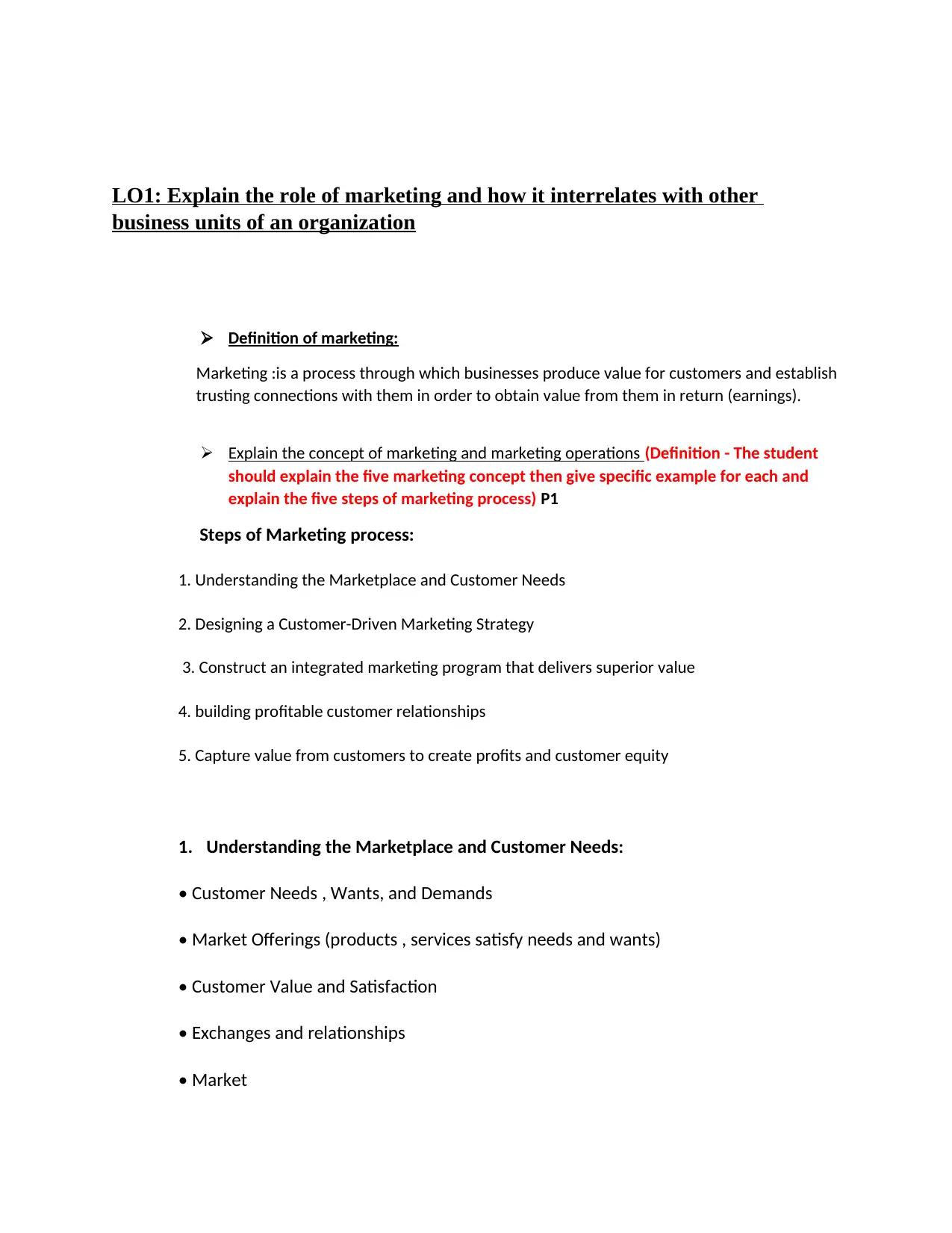
LO1: Explain the role of marketing and how it interrelates with other
business units of an organization
Definition of marketing:
Marketing :is a process through which businesses produce value for customers and establish
trusting connections with them in order to obtain value from them in return (earnings).
Explain the concept of marketing and marketing operations (Definition - The student
should explain the five marketing concept then give specific example for each and
explain the five steps of marketing process) P1
Steps of Marketing process:
1. Understanding the Marketplace and Customer Needs
2. Designing a Customer-Driven Marketing Strategy
3. Construct an integrated marketing program that delivers superior value
4. building profitable customer relationships
5. Capture value from customers to create profits and customer equity
1. Understanding the Marketplace and Customer Needs:
• Customer Needs , Wants, and Demands
• Market Offerings (products , services satisfy needs and wants)
• Customer Value and Satisfaction
• Exchanges and relationships
• Market
business units of an organization
Definition of marketing:
Marketing :is a process through which businesses produce value for customers and establish
trusting connections with them in order to obtain value from them in return (earnings).
Explain the concept of marketing and marketing operations (Definition - The student
should explain the five marketing concept then give specific example for each and
explain the five steps of marketing process) P1
Steps of Marketing process:
1. Understanding the Marketplace and Customer Needs
2. Designing a Customer-Driven Marketing Strategy
3. Construct an integrated marketing program that delivers superior value
4. building profitable customer relationships
5. Capture value from customers to create profits and customer equity
1. Understanding the Marketplace and Customer Needs:
• Customer Needs , Wants, and Demands
• Market Offerings (products , services satisfy needs and wants)
• Customer Value and Satisfaction
• Exchanges and relationships
• Market
Paraphrase This Document
Need a fresh take? Get an instant paraphrase of this document with our AI Paraphraser
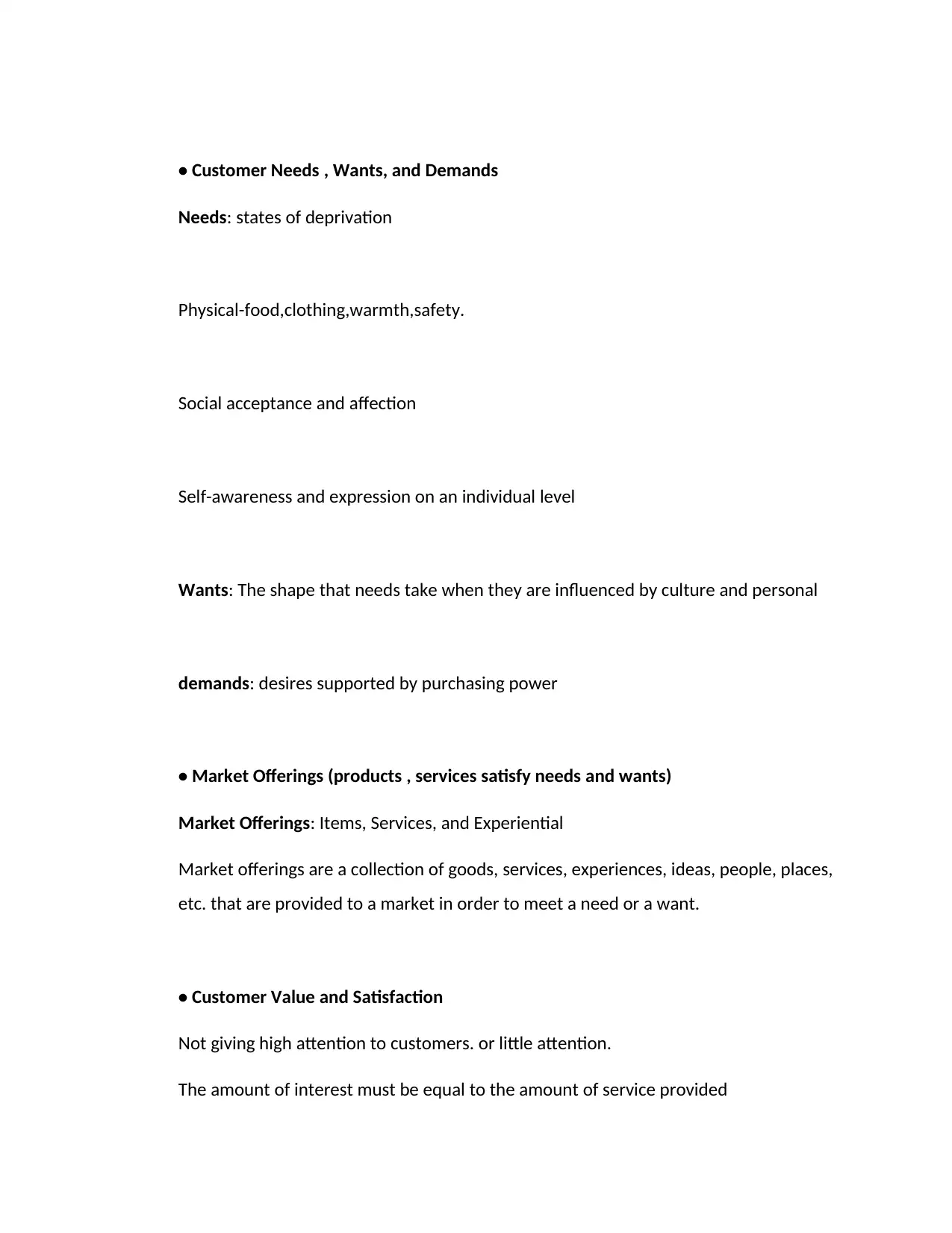
• Customer Needs , Wants, and Demands
Needs: states of deprivation
Physical-food,clothing,warmth,safety.
Social acceptance and affection
Self-awareness and expression on an individual level
Wants: The shape that needs take when they are influenced by culture and personal
demands: desires supported by purchasing power
• Market Offerings (products , services satisfy needs and wants)
Market Offerings: Items, Services, and Experiential
Market offerings are a collection of goods, services, experiences, ideas, people, places,
etc. that are provided to a market in order to meet a need or a want.
• Customer Value and Satisfaction
Not giving high attention to customers. or little attention.
The amount of interest must be equal to the amount of service provided
Needs: states of deprivation
Physical-food,clothing,warmth,safety.
Social acceptance and affection
Self-awareness and expression on an individual level
Wants: The shape that needs take when they are influenced by culture and personal
demands: desires supported by purchasing power
• Market Offerings (products , services satisfy needs and wants)
Market Offerings: Items, Services, and Experiential
Market offerings are a collection of goods, services, experiences, ideas, people, places,
etc. that are provided to a market in order to meet a need or a want.
• Customer Value and Satisfaction
Not giving high attention to customers. or little attention.
The amount of interest must be equal to the amount of service provided
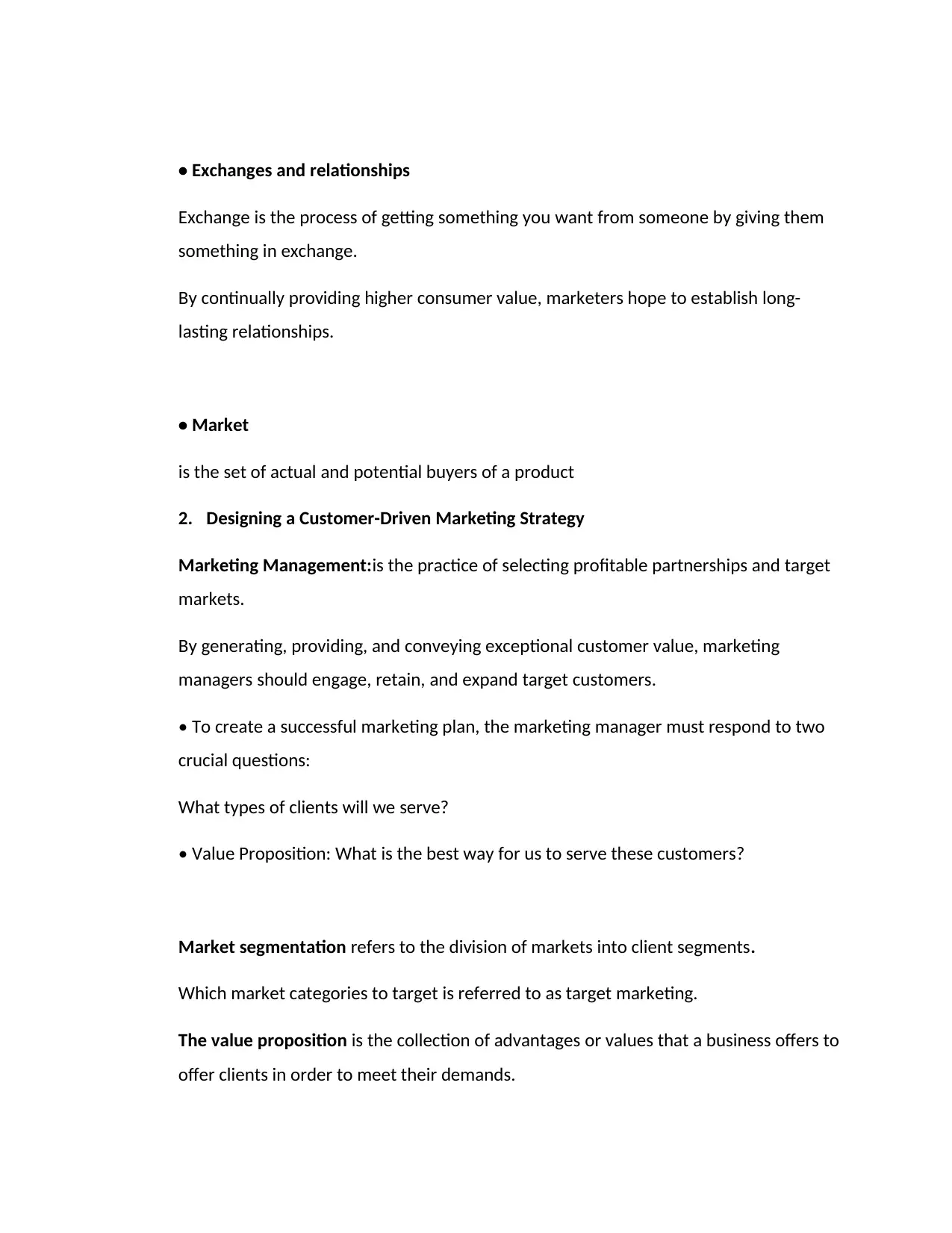
• Exchanges and relationships
Exchange is the process of getting something you want from someone by giving them
something in exchange.
By continually providing higher consumer value, marketers hope to establish long-
lasting relationships.
• Market
is the set of actual and potential buyers of a product
2. Designing a Customer-Driven Marketing Strategy
Marketing Management:is the practice of selecting profitable partnerships and target
markets.
By generating, providing, and conveying exceptional customer value, marketing
managers should engage, retain, and expand target customers.
• To create a successful marketing plan, the marketing manager must respond to two
crucial questions:
What types of clients will we serve?
• Value Proposition: What is the best way for us to serve these customers?
Market segmentation refers to the division of markets into client segments.
Which market categories to target is referred to as target marketing.
The value proposition is the collection of advantages or values that a business offers to
offer clients in order to meet their demands.
Exchange is the process of getting something you want from someone by giving them
something in exchange.
By continually providing higher consumer value, marketers hope to establish long-
lasting relationships.
• Market
is the set of actual and potential buyers of a product
2. Designing a Customer-Driven Marketing Strategy
Marketing Management:is the practice of selecting profitable partnerships and target
markets.
By generating, providing, and conveying exceptional customer value, marketing
managers should engage, retain, and expand target customers.
• To create a successful marketing plan, the marketing manager must respond to two
crucial questions:
What types of clients will we serve?
• Value Proposition: What is the best way for us to serve these customers?
Market segmentation refers to the division of markets into client segments.
Which market categories to target is referred to as target marketing.
The value proposition is the collection of advantages or values that a business offers to
offer clients in order to meet their demands.
⊘ This is a preview!⊘
Do you want full access?
Subscribe today to unlock all pages.

Trusted by 1+ million students worldwide
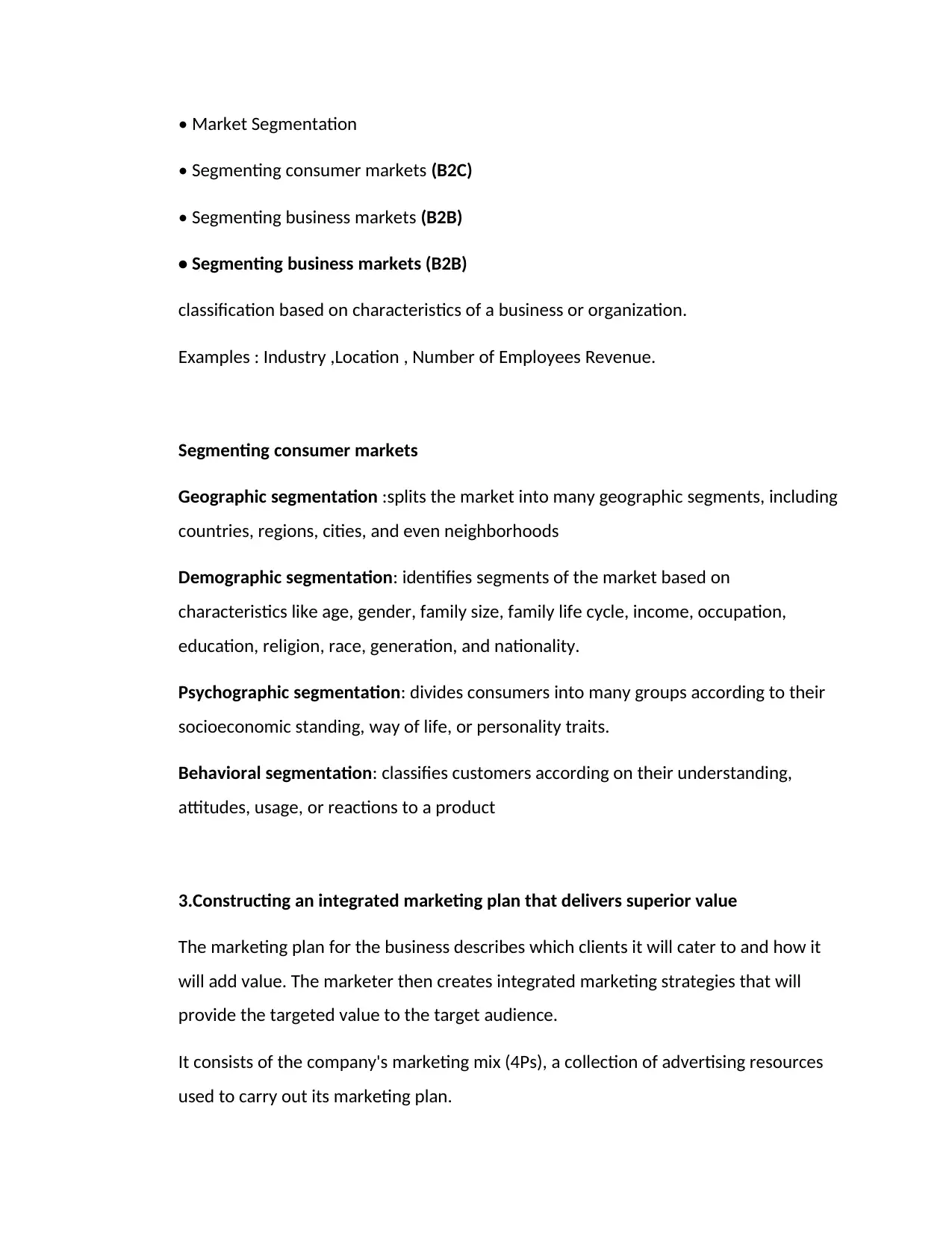
• Market Segmentation
• Segmenting consumer markets (B2C)
• Segmenting business markets (B2B)
• Segmenting business markets (B2B)
classification based on characteristics of a business or organization.
Examples : Industry ,Location , Number of Employees Revenue.
Segmenting consumer markets
Geographic segmentation :splits the market into many geographic segments, including
countries, regions, cities, and even neighborhoods
Demographic segmentation: identifies segments of the market based on
characteristics like age, gender, family size, family life cycle, income, occupation,
education, religion, race, generation, and nationality.
Psychographic segmentation: divides consumers into many groups according to their
socioeconomic standing, way of life, or personality traits.
Behavioral segmentation: classifies customers according on their understanding,
attitudes, usage, or reactions to a product
3.Constructing an integrated marketing plan that delivers superior value
The marketing plan for the business describes which clients it will cater to and how it
will add value. The marketer then creates integrated marketing strategies that will
provide the targeted value to the target audience.
It consists of the company's marketing mix (4Ps), a collection of advertising resources
used to carry out its marketing plan.
• Segmenting consumer markets (B2C)
• Segmenting business markets (B2B)
• Segmenting business markets (B2B)
classification based on characteristics of a business or organization.
Examples : Industry ,Location , Number of Employees Revenue.
Segmenting consumer markets
Geographic segmentation :splits the market into many geographic segments, including
countries, regions, cities, and even neighborhoods
Demographic segmentation: identifies segments of the market based on
characteristics like age, gender, family size, family life cycle, income, occupation,
education, religion, race, generation, and nationality.
Psychographic segmentation: divides consumers into many groups according to their
socioeconomic standing, way of life, or personality traits.
Behavioral segmentation: classifies customers according on their understanding,
attitudes, usage, or reactions to a product
3.Constructing an integrated marketing plan that delivers superior value
The marketing plan for the business describes which clients it will cater to and how it
will add value. The marketer then creates integrated marketing strategies that will
provide the targeted value to the target audience.
It consists of the company's marketing mix (4Ps), a collection of advertising resources
used to carry out its marketing plan.
Paraphrase This Document
Need a fresh take? Get an instant paraphrase of this document with our AI Paraphraser
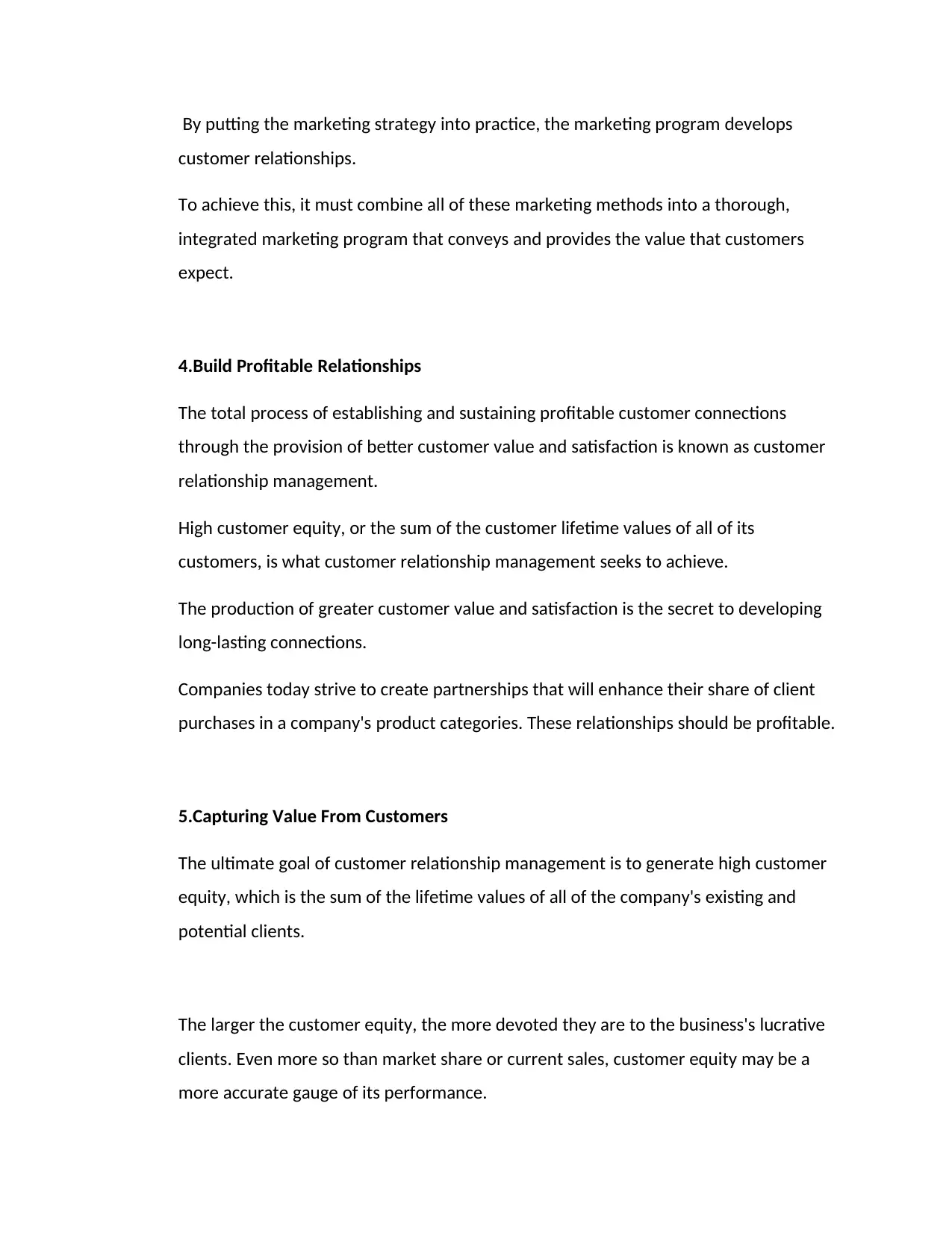
By putting the marketing strategy into practice, the marketing program develops
customer relationships.
To achieve this, it must combine all of these marketing methods into a thorough,
integrated marketing program that conveys and provides the value that customers
expect.
4.Build Profitable Relationships
The total process of establishing and sustaining profitable customer connections
through the provision of better customer value and satisfaction is known as customer
relationship management.
High customer equity, or the sum of the customer lifetime values of all of its
customers, is what customer relationship management seeks to achieve.
The production of greater customer value and satisfaction is the secret to developing
long-lasting connections.
Companies today strive to create partnerships that will enhance their share of client
purchases in a company's product categories. These relationships should be profitable.
5.Capturing Value From Customers
The ultimate goal of customer relationship management is to generate high customer
equity, which is the sum of the lifetime values of all of the company's existing and
potential clients.
The larger the customer equity, the more devoted they are to the business's lucrative
clients. Even more so than market share or current sales, customer equity may be a
more accurate gauge of its performance.
customer relationships.
To achieve this, it must combine all of these marketing methods into a thorough,
integrated marketing program that conveys and provides the value that customers
expect.
4.Build Profitable Relationships
The total process of establishing and sustaining profitable customer connections
through the provision of better customer value and satisfaction is known as customer
relationship management.
High customer equity, or the sum of the customer lifetime values of all of its
customers, is what customer relationship management seeks to achieve.
The production of greater customer value and satisfaction is the secret to developing
long-lasting connections.
Companies today strive to create partnerships that will enhance their share of client
purchases in a company's product categories. These relationships should be profitable.
5.Capturing Value From Customers
The ultimate goal of customer relationship management is to generate high customer
equity, which is the sum of the lifetime values of all of the company's existing and
potential clients.
The larger the customer equity, the more devoted they are to the business's lucrative
clients. Even more so than market share or current sales, customer equity may be a
more accurate gauge of its performance.
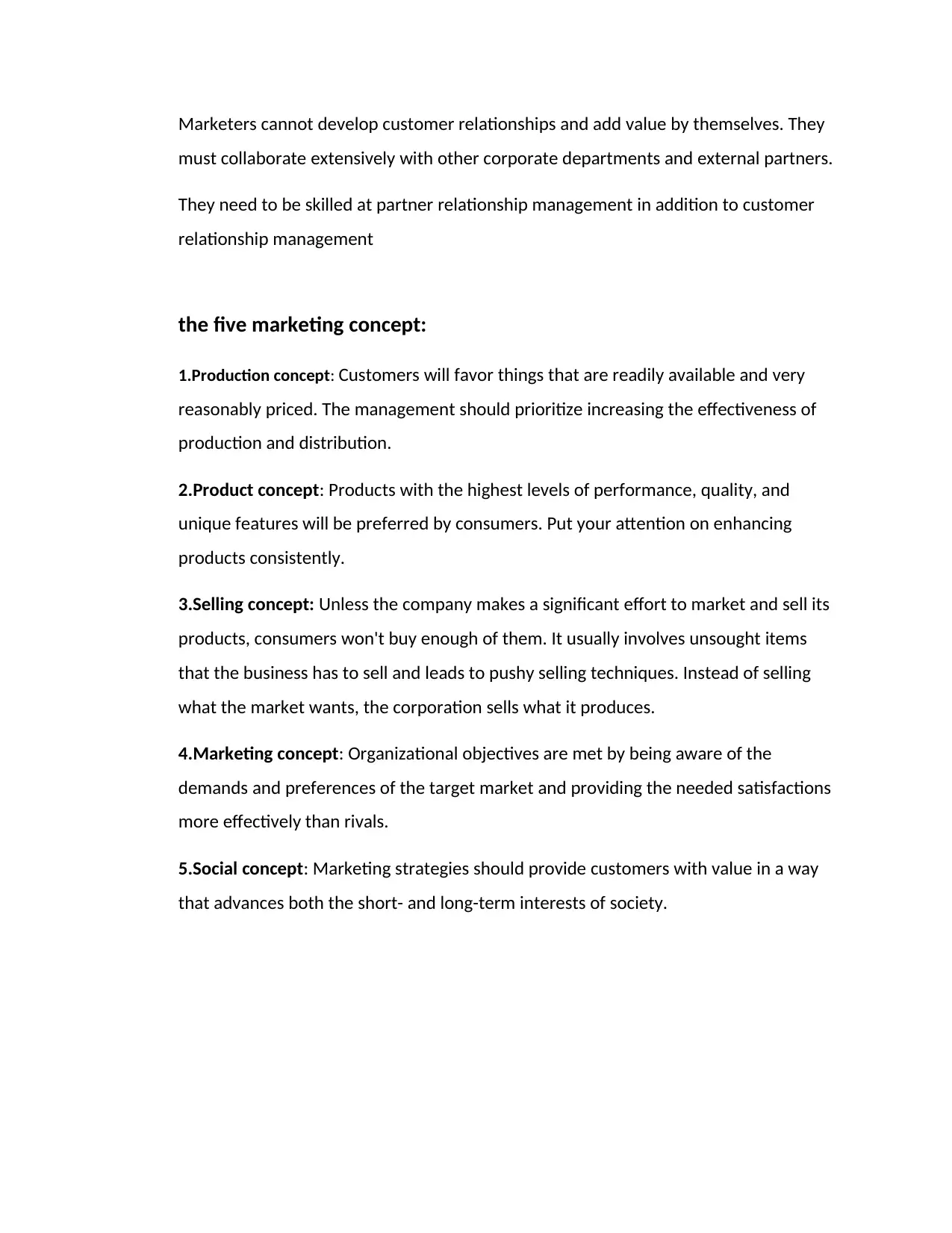
Marketers cannot develop customer relationships and add value by themselves. They
must collaborate extensively with other corporate departments and external partners.
They need to be skilled at partner relationship management in addition to customer
relationship management
the five marketing concept:
1.Production concept: Customers will favor things that are readily available and very
reasonably priced. The management should prioritize increasing the effectiveness of
production and distribution.
2.Product concept: Products with the highest levels of performance, quality, and
unique features will be preferred by consumers. Put your attention on enhancing
products consistently.
3.Selling concept: Unless the company makes a significant effort to market and sell its
products, consumers won't buy enough of them. It usually involves unsought items
that the business has to sell and leads to pushy selling techniques. Instead of selling
what the market wants, the corporation sells what it produces.
4.Marketing concept: Organizational objectives are met by being aware of the
demands and preferences of the target market and providing the needed satisfactions
more effectively than rivals.
5.Social concept: Marketing strategies should provide customers with value in a way
that advances both the short- and long-term interests of society.
must collaborate extensively with other corporate departments and external partners.
They need to be skilled at partner relationship management in addition to customer
relationship management
the five marketing concept:
1.Production concept: Customers will favor things that are readily available and very
reasonably priced. The management should prioritize increasing the effectiveness of
production and distribution.
2.Product concept: Products with the highest levels of performance, quality, and
unique features will be preferred by consumers. Put your attention on enhancing
products consistently.
3.Selling concept: Unless the company makes a significant effort to market and sell its
products, consumers won't buy enough of them. It usually involves unsought items
that the business has to sell and leads to pushy selling techniques. Instead of selling
what the market wants, the corporation sells what it produces.
4.Marketing concept: Organizational objectives are met by being aware of the
demands and preferences of the target market and providing the needed satisfactions
more effectively than rivals.
5.Social concept: Marketing strategies should provide customers with value in a way
that advances both the short- and long-term interests of society.
⊘ This is a preview!⊘
Do you want full access?
Subscribe today to unlock all pages.

Trusted by 1+ million students worldwide
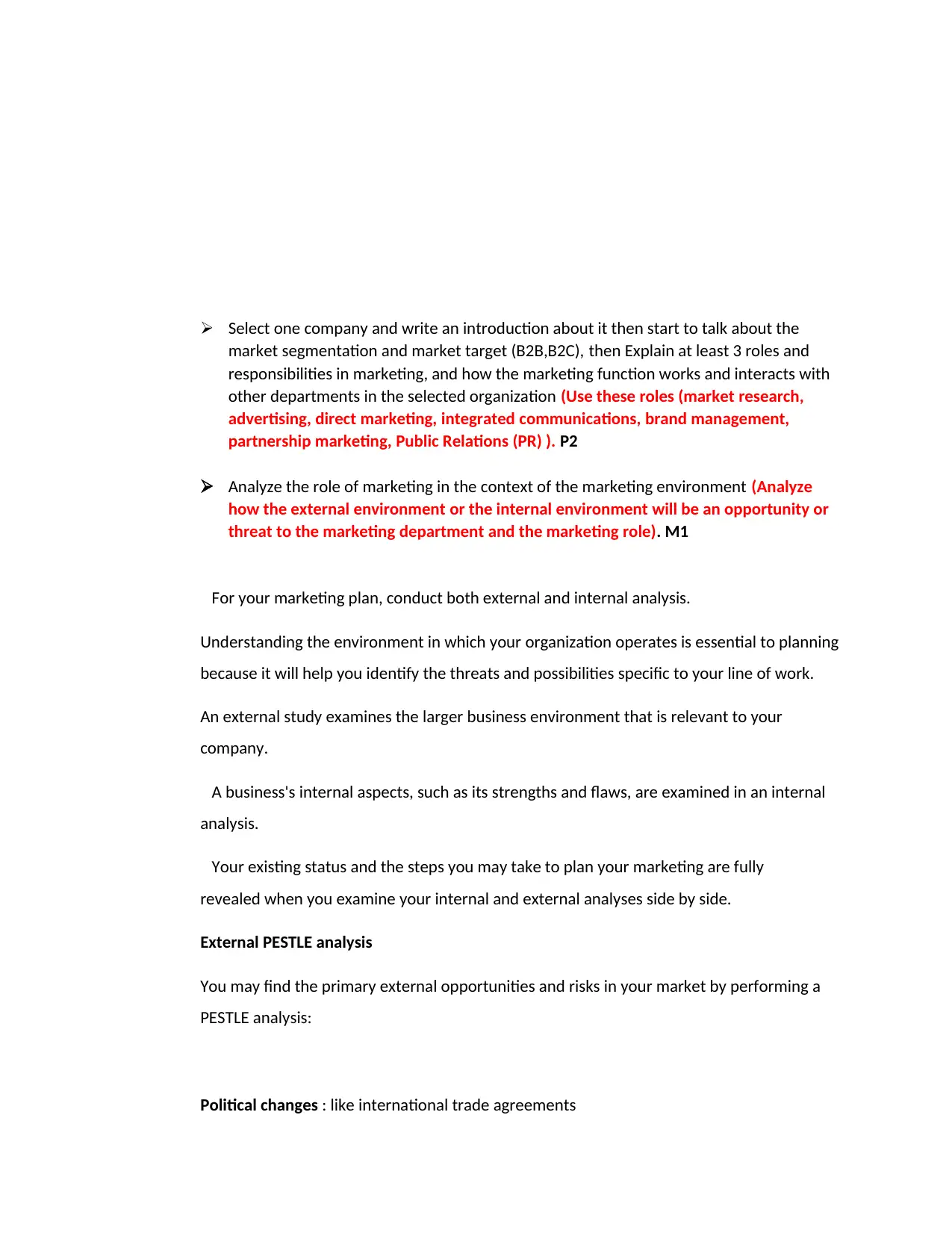
Select one company and write an introduction about it then start to talk about the
market segmentation and market target (B2B,B2C), then Explain at least 3 roles and
responsibilities in marketing, and how the marketing function works and interacts with
other departments in the selected organization (Use these roles (market research,
advertising, direct marketing, integrated communications, brand management,
partnership marketing, Public Relations (PR) ). P2
Analyze the role of marketing in the context of the marketing environment (Analyze
how the external environment or the internal environment will be an opportunity or
threat to the marketing department and the marketing role). M1
For your marketing plan, conduct both external and internal analysis.
Understanding the environment in which your organization operates is essential to planning
because it will help you identify the threats and possibilities specific to your line of work.
An external study examines the larger business environment that is relevant to your
company.
A business's internal aspects, such as its strengths and flaws, are examined in an internal
analysis.
Your existing status and the steps you may take to plan your marketing are fully
revealed when you examine your internal and external analyses side by side.
External PESTLE analysis
You may find the primary external opportunities and risks in your market by performing a
PESTLE analysis:
Political changes : like international trade agreements
market segmentation and market target (B2B,B2C), then Explain at least 3 roles and
responsibilities in marketing, and how the marketing function works and interacts with
other departments in the selected organization (Use these roles (market research,
advertising, direct marketing, integrated communications, brand management,
partnership marketing, Public Relations (PR) ). P2
Analyze the role of marketing in the context of the marketing environment (Analyze
how the external environment or the internal environment will be an opportunity or
threat to the marketing department and the marketing role). M1
For your marketing plan, conduct both external and internal analysis.
Understanding the environment in which your organization operates is essential to planning
because it will help you identify the threats and possibilities specific to your line of work.
An external study examines the larger business environment that is relevant to your
company.
A business's internal aspects, such as its strengths and flaws, are examined in an internal
analysis.
Your existing status and the steps you may take to plan your marketing are fully
revealed when you examine your internal and external analyses side by side.
External PESTLE analysis
You may find the primary external opportunities and risks in your market by performing a
PESTLE analysis:
Political changes : like international trade agreements
Paraphrase This Document
Need a fresh take? Get an instant paraphrase of this document with our AI Paraphraser
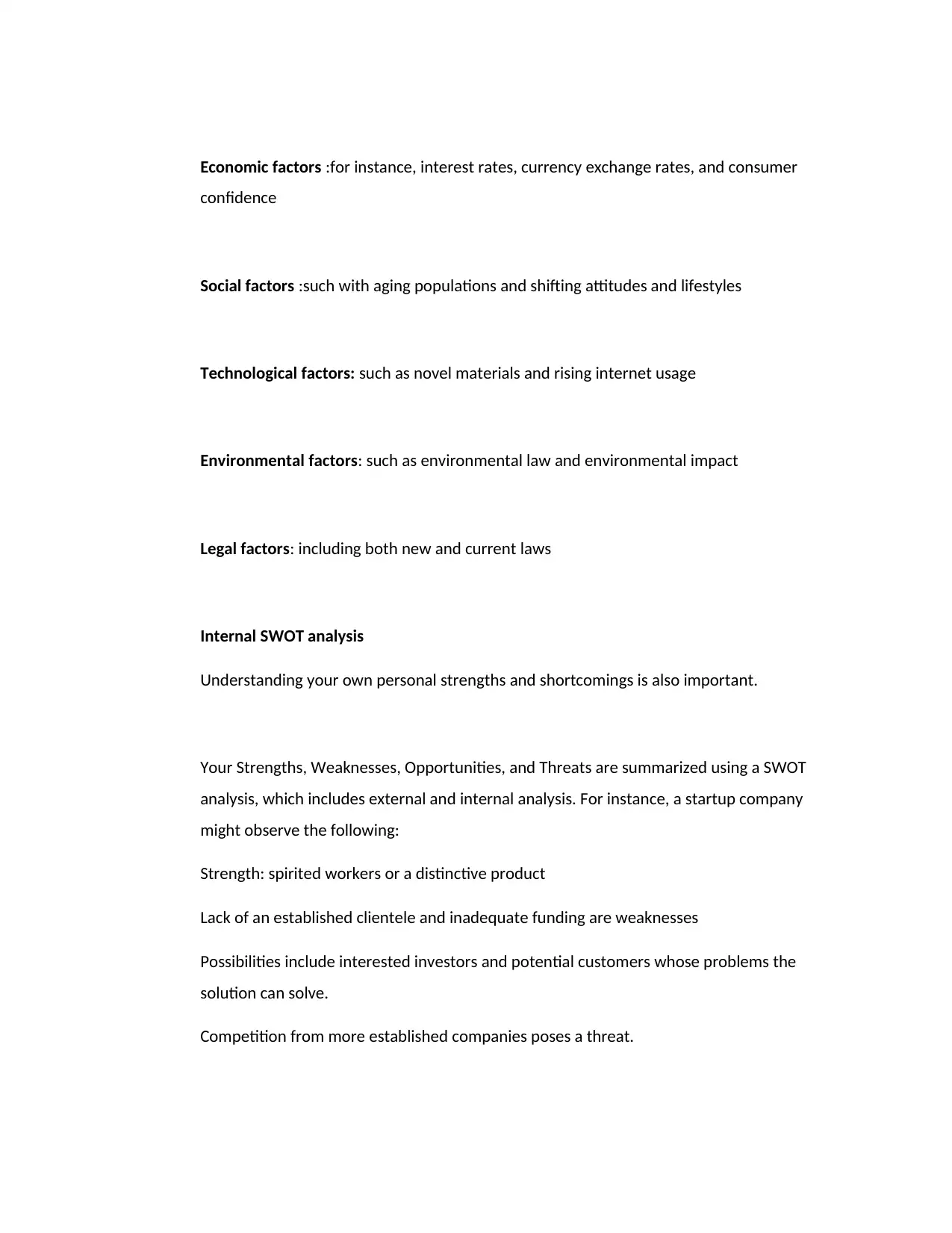
Economic factors :for instance, interest rates, currency exchange rates, and consumer
confidence
Social factors :such with aging populations and shifting attitudes and lifestyles
Technological factors: such as novel materials and rising internet usage
Environmental factors: such as environmental law and environmental impact
Legal factors: including both new and current laws
Internal SWOT analysis
Understanding your own personal strengths and shortcomings is also important.
Your Strengths, Weaknesses, Opportunities, and Threats are summarized using a SWOT
analysis, which includes external and internal analysis. For instance, a startup company
might observe the following:
Strength: spirited workers or a distinctive product
Lack of an established clientele and inadequate funding are weaknesses
Possibilities include interested investors and potential customers whose problems the
solution can solve.
Competition from more established companies poses a threat.
confidence
Social factors :such with aging populations and shifting attitudes and lifestyles
Technological factors: such as novel materials and rising internet usage
Environmental factors: such as environmental law and environmental impact
Legal factors: including both new and current laws
Internal SWOT analysis
Understanding your own personal strengths and shortcomings is also important.
Your Strengths, Weaknesses, Opportunities, and Threats are summarized using a SWOT
analysis, which includes external and internal analysis. For instance, a startup company
might observe the following:
Strength: spirited workers or a distinctive product
Lack of an established clientele and inadequate funding are weaknesses
Possibilities include interested investors and potential customers whose problems the
solution can solve.
Competition from more established companies poses a threat.
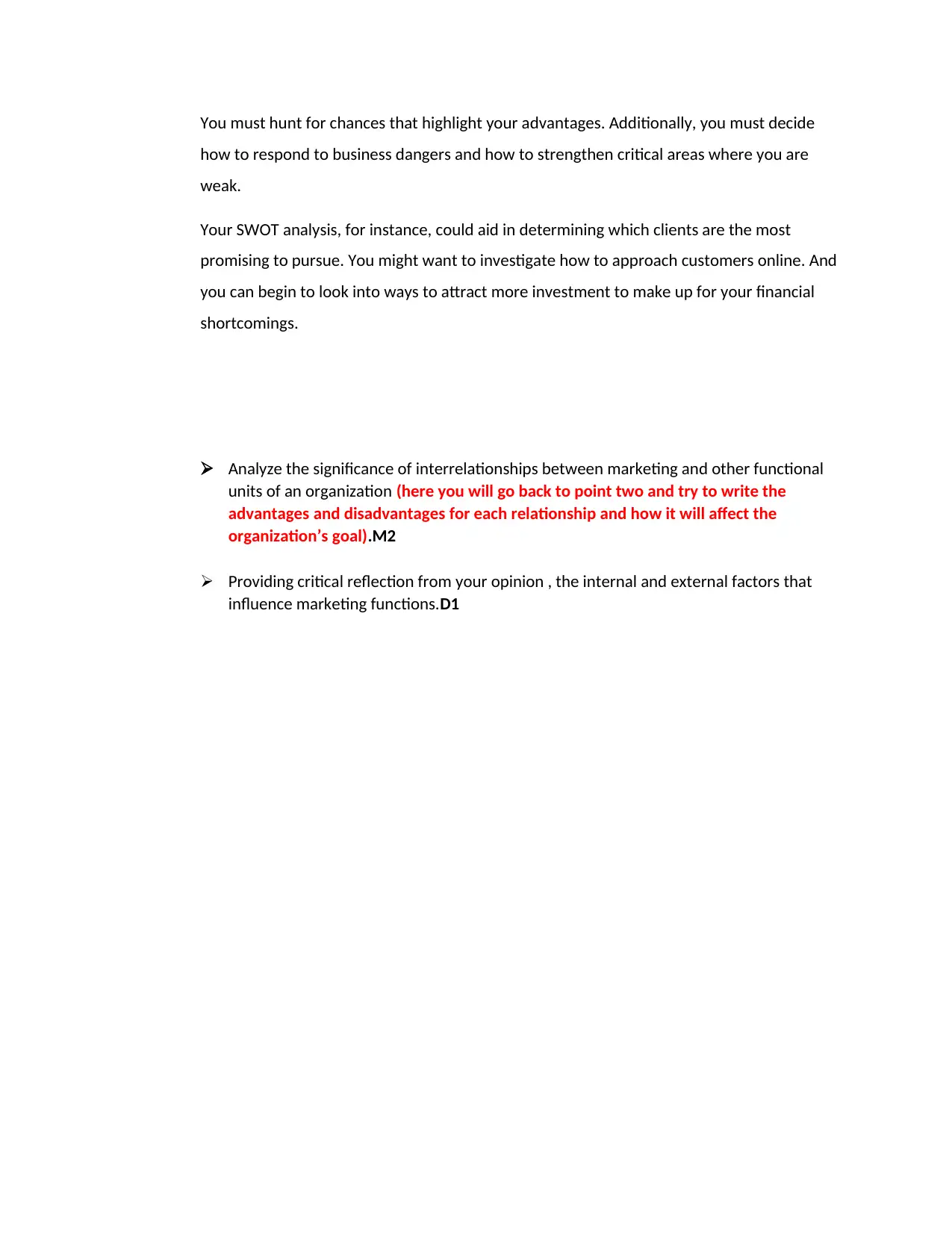
You must hunt for chances that highlight your advantages. Additionally, you must decide
how to respond to business dangers and how to strengthen critical areas where you are
weak.
Your SWOT analysis, for instance, could aid in determining which clients are the most
promising to pursue. You might want to investigate how to approach customers online. And
you can begin to look into ways to attract more investment to make up for your financial
shortcomings.
Analyze the significance of interrelationships between marketing and other functional
units of an organization (here you will go back to point two and try to write the
advantages and disadvantages for each relationship and how it will affect the
organization’s goal).M2
Providing critical reflection from your opinion , the internal and external factors that
influence marketing functions.D1
how to respond to business dangers and how to strengthen critical areas where you are
weak.
Your SWOT analysis, for instance, could aid in determining which clients are the most
promising to pursue. You might want to investigate how to approach customers online. And
you can begin to look into ways to attract more investment to make up for your financial
shortcomings.
Analyze the significance of interrelationships between marketing and other functional
units of an organization (here you will go back to point two and try to write the
advantages and disadvantages for each relationship and how it will affect the
organization’s goal).M2
Providing critical reflection from your opinion , the internal and external factors that
influence marketing functions.D1
⊘ This is a preview!⊘
Do you want full access?
Subscribe today to unlock all pages.

Trusted by 1+ million students worldwide
1 out of 9
Related Documents
Your All-in-One AI-Powered Toolkit for Academic Success.
+13062052269
info@desklib.com
Available 24*7 on WhatsApp / Email
![[object Object]](/_next/static/media/star-bottom.7253800d.svg)
Unlock your academic potential
Copyright © 2020–2025 A2Z Services. All Rights Reserved. Developed and managed by ZUCOL.




